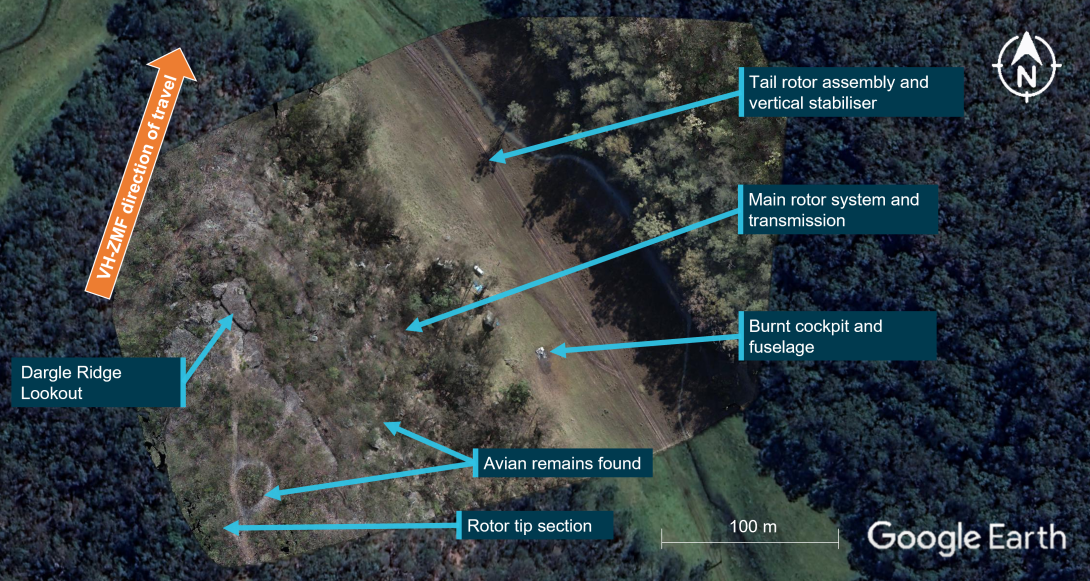
Sun glare and a required radio frequency change meant it was unlikely that the pilot of a LongRanger helicopter saw or had time to avoid a wedgetail eagle before the helicopter struck the bird, an ATSB investigation details.
The Bell 206L-1 LongRanger helicopter had departed a private property at Cattai, north-west of Sydney, for a short flight north to nearby St Albans on the morning of 9 July 2022. About 9 minutes into the flight, as the helicopter crossed Dargle Ridge at a height of about 500 feet above the ground, the helicopter struck a wedgetail eagle just below the front left windscreen.
“The pilot was likely startled by sighting the bird or the helicopter striking the bird, reacting via abrupt control inputs,” said ATSB Director Transport Safety Dr Stuart Godley.
“Unfortunately, these inputs led to the main rotor striking and severing the tail boom, and the helicopter breaking up in flight.”
Several witnesses described seeing the helicopter enter into a rapid banking turn to the right while pitching up, and hearing several rotor beats change tone before a final louder noise.
Witnesses then recalled the helicopter pitching and rolling while descending, with one witness describing separation of the main rotor blades from the helicopter.
The main fuselage subsequently impacted the ground below the ridge in an area of open farmland. The pilot was fatally injured and the helicopter was destroyed by a post-impact fire.
Footage taken from a media helicopter, which was in the area filming flooding and had landed near the accident site to render assistance, showed biological matter on the accident helicopter’s left nose cowl before the wreckage was consumed by the fire. Other bird matter and biological tissue was recovered from the accident site.
Subsequent testing of the specimens by the Australian Centre for Wildlife Genomics confirmed them as being from an Aquila audax, or wedgetail eagle.
At the time of the accident the weather conditions were described as sunny, with light winds, blue skies and little cloud. However, an assessment of the time of day (about 1145am) and sun position relative to the aircraft’s altitude and track direction indicated that the helicopter was flying directly into the sun.
Further, due to the size and shape of the helicopter’s windscreen, the sun was almost directly at the top of centre of the pilot’s field of view.
The accident also occurred as the helicopter approached the control boundary for airspace surrounding the nearby Richmond air base, requiring the pilot to change radio frequencies. This meant the pilot needed to shift their vision and attention from outside of the cockpit to inside the cockpit to change the frequency on the radio.
“It was unlikely that the pilot saw or had time to avoid the wedgetail eagle due to sun glare and the required radio frequency change.”
Dr Godley noted that birdstrikes are a common occurrence in aviation. In the 5 years between 2018 and 2022, 212 birdstrikes involving helicopters were reported to the ATSB, however only one of those, the accident flight, resulted in the loss of the helicopter.
More broadly, over the 15 years between 2008 and 2022, 24,106 birdstrikes were reported to ATSB for all sectors of aviation.
“Birdstrike is sometimes an unavoidable and relatively common hazard for all aviation operations, one which is more prevalent at lower altitudes,” Dr Godley said.
“A sound lookout and visual scanning processes, as well as avoidance of low-level flight and expected areas of large concentrations of birds are key to reducing the likelihood of birdstrike.”
Read the report: Birdstrike and in-flight break-up involving a Bell 206L-1, VH ZMF Near Maroota, NSW, on 9 July 2022


